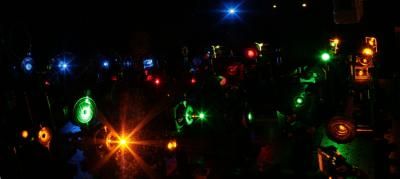Biophysicists manipulate "zipper," reveal protein folding dynamics
Single-molecule, real-time measurements of a key biological process:
Biophysicists at TUM, the Technische Universität München, have published the results of single-molecule experiments that bring a higher-resolution tool to the study of protein folding. How proteins arrive at the three-dimensional shapes that determine their essential functions – or cause grave diseases when folding goes wrong – is considered one of the most important and least understood questions in the biological and medical sciences. Folding itself follows a path determined by its energy landscape, a complex property described in unprecedented detail by the TUM researchers. In Proceedings of the National Academy of Sciences (USA), they report taking hold of a single, zipper-like protein molecule and mapping changes in its energy landscape during folding and unfolding.
Previous studies, including atomic force microscopy experiments by the same Munich laboratory, have gone a long way toward characterizing energy thresholds or barriers that stand between a protein's unfolded and folded states. Detailed observations of the quick transition from one state to the other have remained elusive. The results published this week open the door to higher-resolution, direct measurements. Better characterization of the folding process is seen as a vital link in understanding the chain of events leading from DNA coding for a protein to that protein's biological function. Another motivation for research in this field is the search for new drugs and therapies, because malfunctions in protein folding are implicated in a number of serious diseases – including diabetes, cancer, cystic fibrosis, prion diseases, and Alzheimer's.
This is the latest in a long series of single-molecule biophysical experiments carried out by Professor Matthias Rief and colleagues in the TUM Department of Physics. Co-authors Christof Gebhardt and Thomas Bornschlögl are members of Rief's lab; Gebhardt also is a member of the Munich Center for Integrated Protein Science.
As a model system for studying real-time protein folding dynamics, the TUM scientists chose a so-called leucine zipper found in yeast. It offers, as proteins go, a relatively simple "coiled coil" structure and zipper-like folding action: Picture two amino acid strings side by side, joined at the bottom, open at the top, and made essentially to zip together.
The researchers extended this structure so that they could make independent measurements at the top, bottom, and middle parts of the zipper. They took hold of the free ends at the top of the zipper with handles made of double-stranded DNA. These DNA handles in turn were attached to tiny beads that could be directly manipulated by "optical tweezers" – a tool based on the ability of laser beams with a certain kind of profile to pin down nanoscale objects. One end of the protein molecule was held fixed, and the other was held under tension but with some freedom to move, so that folding dynamics could be measured directly, in real time, as the protein zipped and unzipped. This arrangement enabled measurements with high resolution in both space and time.
"What I consider the major improvement is that the new experiments allow the observation of thousands of transitions between the folded and the unfolded state," Rief said. "This enables us to detect not only the folded and unfolded states but also, directly, the excursions of the large energy barriers separating those states. This has previously been impossible, and it now allows direct insight into the precise energy profile of this barrier."
Original publication: J. Christof M. Gebhardt, Thomas Bornschlögl, and Matthias Rief; "Full distance resolved folding energy landscape of one single protein molecule"; PNAS Early Edition 2010.
Most read news
Topics
Organizations
Other news from the department science

Get the life science industry in your inbox
By submitting this form you agree that LUMITOS AG will send you the newsletter(s) selected above by email. Your data will not be passed on to third parties. Your data will be stored and processed in accordance with our data protection regulations. LUMITOS may contact you by email for the purpose of advertising or market and opinion surveys. You can revoke your consent at any time without giving reasons to LUMITOS AG, Ernst-Augustin-Str. 2, 12489 Berlin, Germany or by e-mail at revoke@lumitos.com with effect for the future. In addition, each email contains a link to unsubscribe from the corresponding newsletter.



















































